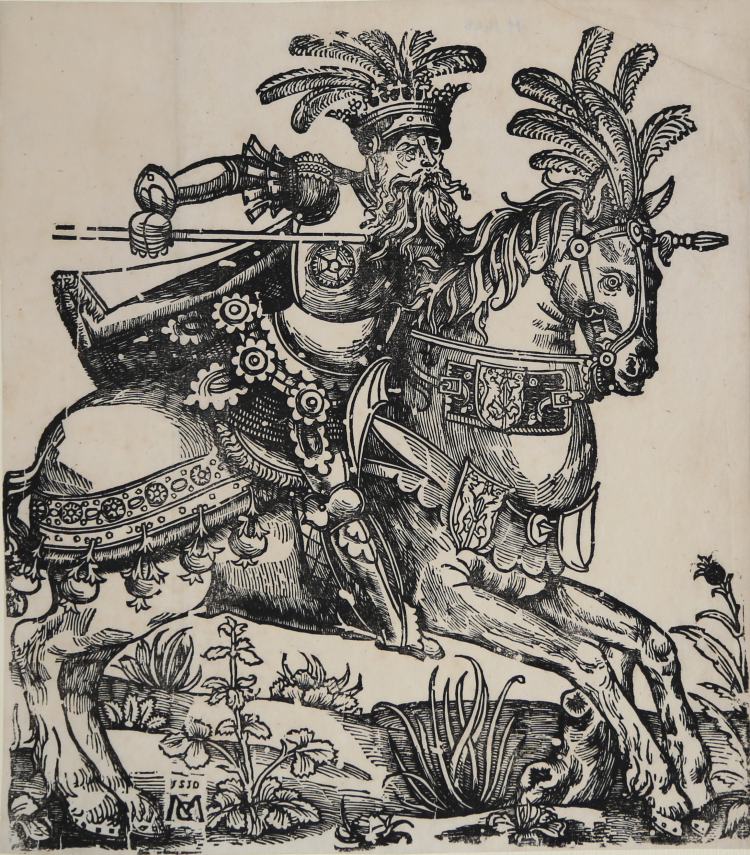




| Reference: | S25177 |
| Author | Matthias GERUNG |
| Year: | 1550 ca. |
| Measures: | 270 x 310 mm |



| Reference: | S25177 |
| Author | Matthias GERUNG |
| Year: | 1550 ca. |
| Measures: | 270 x 310 mm |
Woodcut, 1550, dated and signed in the woodblock.
A magnificent impression, printed on contemporary laid paper with watermark unreadable, showing the borderline. slight crease of paper upper right corner, otherwise in perfect condition.
Matthias Gerung, in older literature Geron Mathias, was a German painter and printmaker. It was probably the son of the violinist Matthias and pupil of Han Schaufelin, although someone says Hans Burgkmair. In addition to being a painter, is also known as master of the woodcut, especially for the illustration of the Bible Ottheinrich, which is one of the most precious illuminated manuscripts in the world. Nagler gives him 23 different works, some of which are multiple, mostly of a religious nature, and citing this work. Although lacking the classic scene of the killing of the dragon, this work would appear to represent Saint George, Saint - more than any other rider who has represented the ideology of chivalry, a defender of the innocent and vanquishes the evil antagonist.
|
Nagler, Die Monogrammisten, pp. 569/573, 1824.
|
Matthias GERUNG (Nördlingen circa 1500 – Lausingen 1570 )
|
Pupil of Hans Schäufelein in Nördlingen. From 1525, he lived in Lauingen, where he worked for the Palatine Count Ottheinrich For Ottheinrich, he illuminated the New Testament and Apocalypse of a fifteenth-century Bible in 1530-31 (Gotha, Landesbibliothek); ); produced a cycle of paintings with the history of Paris and the destruction of Troy for a room in his castle at Neuburg c.1540; and designed a series of tapestries with scenes from the Count's life from 1533 to 1543. His most important work is the series of woodc uts accompanying Sebastian Meyer's commentary on the Apocalypse begun in 1544. His latest work is also his best-known painting, the 'Melancholia' of 1558, which was inspired by Dürer's engraving, 1912,1220.2 (Karlsruhe, Kunsthalle). The majority of Gerung's seventy-seven woodcuts recorded in Hollstein are for the Apocalypse series; he also designed large multi-block religious compositions of which a few have survived. His work is quite distinctive, and apart from a few architectural elements and ornamental borders (such as Hollstein, 8 and 76) with classical motifs, contains none of the influence of Italian art which affected many of his contemporaries.
|
|
Nagler, Die Monogrammisten, pp. 569/573, 1824.
|
Matthias GERUNG (Nördlingen circa 1500 – Lausingen 1570 )
|
Pupil of Hans Schäufelein in Nördlingen. From 1525, he lived in Lauingen, where he worked for the Palatine Count Ottheinrich For Ottheinrich, he illuminated the New Testament and Apocalypse of a fifteenth-century Bible in 1530-31 (Gotha, Landesbibliothek); ); produced a cycle of paintings with the history of Paris and the destruction of Troy for a room in his castle at Neuburg c.1540; and designed a series of tapestries with scenes from the Count's life from 1533 to 1543. His most important work is the series of woodc uts accompanying Sebastian Meyer's commentary on the Apocalypse begun in 1544. His latest work is also his best-known painting, the 'Melancholia' of 1558, which was inspired by Dürer's engraving, 1912,1220.2 (Karlsruhe, Kunsthalle). The majority of Gerung's seventy-seven woodcuts recorded in Hollstein are for the Apocalypse series; he also designed large multi-block religious compositions of which a few have survived. His work is quite distinctive, and apart from a few architectural elements and ornamental borders (such as Hollstein, 8 and 76) with classical motifs, contains none of the influence of Italian art which affected many of his contemporaries.
|